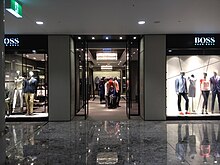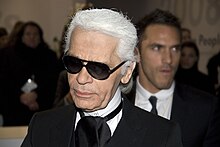German fashion: Difference between revisions
→Brands: Added MCM as it's one of the most iconic German luxury fashion brands for nearly 45 years. |
mNo edit summary |
||
| Line 65: | Line 65: | ||
*[[Berlin University of the Arts]]<ref>{{cite web|url=https://www.design.udk-berlin.de/|title=Studiengang Design - Universität der Künste Berlin|access-date=19 June 2015}}</ref> |
*[[Berlin University of the Arts]]<ref>{{cite web|url=https://www.design.udk-berlin.de/|title=Studiengang Design - Universität der Künste Berlin|access-date=19 June 2015}}</ref> |
||
*[[Hochschule für Technik und Wirtschaft|HTW Berlin]] |
*[[Hochschule für Technik und Wirtschaft|HTW Berlin]] |
||
*[[Lette-Verein|Lette-Verein Berlin]] Fashion and Design School |
|||
*[[Weissensee (Berlin)|Weissensee]] Academy of Arts<ref>{{cite web|url=https://www.kh-berlin.de/en.html|title=Weißensee Kunsthochschule Berlin|access-date=19 June 2015}}</ref> |
*[[Weissensee (Berlin)|Weissensee]] Academy of Arts<ref>{{cite web|url=https://www.kh-berlin.de/en.html|title=Weißensee Kunsthochschule Berlin|access-date=19 June 2015}}</ref> |
||
Revision as of 13:30, 10 June 2021

Germany is a leading country in the fashion industry, along with France, Italy, Spain, the United States, the United Kingdom and Japan. German fashion is known for its elegant lines, unconventional young designs, and manufacturers of sports and outdoor clothing.
Berlin is the center of young and creative fashion in Germany, prominently displayed at Berlin Fashion Week.[1] Düsseldorf is an important fashion trade center with Igedo. Other important centers of the scene are Munich,[2] Hamburg and Cologne.[3] Smaller places are also important design and production hubs of the German fashion industry, such as Herford, Metzingen, Herzogenaurach, Schorndorf, Chemnitz, Albstadt and Detmold.[4]
German fashion is popular as ready-to-wear and custom-made creations.[5]
Economy
In around 1,300 companies with more than 130,000 employees, a revenue of 28 billion Euro is generated by the German textile industry. Almost 44 percent of the products are exported. The textile branch thus is the second largest producer of consumer goods in Germany, after food production.[6][7]
Brands

Famous fashion brands include MCM, Hugo Boss, Adidas, PUMA, Escada, JOOP!, MCM, Bruno Banani, Jil Sander, Triumph, Schiesser, Closed, Reusch, Valisere, Jack Wolfskin, Ulla Popken, Buffalo, Rohde, Marc O'Polo, Tom Tailor, s.Oliver, Esprit, Wunderkind, Seidensticker, Windsor., Jaques Britt, Naketano.
There are also various agencies hosting multiple German brands and designers at once, such as zLabels Berlin.[8] Also the big department stores like Kaufhof and Karstadt, retail chains like Peek & Cloppenburg, Ulla Popken and NewYorker or mail order and online shops like Otto and Zalando have various in-house fashion brands.
Fairs
The Bread & Butter in Berlin[9] is a leading trade fair for street fashion and ready-to-wear trends, twice annually during Berlin Fashion Week.[1][10][11] The Igedo fair Collection Première Düsseldorf in Düsseldorf (CPD) was the world's dominating fashion fair for years.[12]
Designers

Renowned fashion designers from Germany are e.g. Karl Lagerfeld, Hugo Boss, Wolfgang Joop, Jil Sander, Michael Michalsky, Etienne Aigner, Tomas Maier, Robert Geller, Philipp Plein, Rudolph Moshammer, Torsten Amft, Uli Herzner, Gabriele Strehle, Christoph Tisch, Willy Bogner, Rudolf and Adi Dassler.[13]
Media
Important fashion media of Germany include the German Vogue, Elle, InStyle, Cosmopolitan, Vanity Fair, Jolie, Glamour, Grazia, Life&Style and Sleek magazines. The German fashion magazine with the longest continued tradition is Burda Style, that was first published by Aenne Burda in 1950, who also established the major Bauer Media Group. Also various general women magazines and tabloids like Joy, Brigitte, Petra, Gala and Bunte are influential in regards to fashion perception.
As for television, FashionTV can be received via cable or satellite. Various casting shows reach a large audience in Germany, including Germany's Next Topmodel by Heidi Klum. Also on ProSieben, the series Fashion Hero starring Claudia Schiffer was looking for fashion design talents. The Shopping Queen format at VOX stars designer Guido Maria Kretschmer, it provides five contestants with 500 EUR to buy them a fashion outfit and styling in four hours, to compete with each other.
Agencies
Important modeling agency locations in Germany are Berlin (izaio, CORE Artist Management, Seeds Models, Viva Models, OneEins), Munich (Louisa Models, Most Wanted Models, Munich Models, Nova Models, Talents München, Vivienne Models) and Hamburg ( CORE Artist Management, MGM Models, iconic management, m 4 models, Mega Models, Model Management, Modelwerk, Most Wanted Models, Place Models, PMA Models). Also agencies in Vienna and Zurich host models based in Germany, as well as major global agencies like IMG Models, DNA, Elite, Models 1 and NEXT.[14]
Models
There is a range of fashion models from Germany that made it to international fame, such as Claudia Schiffer, Heidi Klum, Diane Kruger, Eva Padberg, Toni Garrn, Julia Stegner, Tatjana Patitz, Anna Ewers, Manon von Gerkan, Birte Glang, Nico, Uschi Obermaier, Carola Remer, Franziska Knuppe, Vanessa Hegelmaier, Lena Gercke, Sara Nuru, Barbara Meier, Nadja Auermann, Claudia Ciesla, Aslı Bayram, Shermine Shahrivar, Evelyn Sharma, Victoria Jancke, Marten Laciny, Nico Schwanz and Lars Burmeister.[15]
Education
Fashion education in Germany is centered on art schools, universities and the major fashion manufacturers.[16]
Academic institutions that offer courses in fashion design include:
- Multiple locations
- Berlin, Düsseldorf, Hamburg, Munich: AMD Academy of Fashion and Design[17][18]
- Leipzig, Schwerin: Design Hochschule[19]
- Berlin

- Berlin University of the Arts[20]
- HTW Berlin
- Lette-Verein Berlin Fashion and Design School
- Weissensee Academy of Arts[21]
- Others
- Bremen: University of the Arts Bremen
- Düsseldorf: Kunstakademie Düsseldorf
- Halle: Giebichenstein Castle Academy of Arts
- Hamburg: HAW Hamburg
- Karlsruhe: Academy of Fine Arts
- Munich: Academy of Fine Arts
- Nuremberg: Academy of Fine Arts
External links
![]() Media related to Fashion of Germany at Wikimedia Commons
Media related to Fashion of Germany at Wikimedia Commons
References
- Stern Magazine Style-Extra - Deutsche Mode (German)
- ^ a b "Berlin as a fashion capital: the improbable rise". Fashion United UK. Retrieved 24 May 2014.
- ^ Munich - The stuff dreams are made of (German), Welt
- ^ Men’s Fashions in Cologne, Cologne developed into the capital of men’s fashion in the Federal Republic; twice a year, it was the site of International Men’s Fashion Week [Internationale Herrenmodewoche]., GHDI
- ^ Die deutsche Mode kommt aus der Provinz (The German fashion also comes from the province), Brigitte, Issue 15/2012, retrieved January 18, 2014 (German)
- ^ Stars tragen deutsche Mode Archived 2014-10-28 at the Wayback Machine (Stars wear German fashion), Vogue, August 12, 2013, retrieved January 18, 2014 (German)
- ^ "BMWI Branchenfokus Textil und Bekleidung". Retrieved 28 September 2014.
- ^ "2014 Annual Economic Report". Federal Ministry for Economic Affairs and Energy BMWi. Retrieved 1 November 2014.
- ^ "zLabels". Retrieved 19 June 2015.
- ^ "B&b -BBB". B&b. Archived from the original on 25 August 2012. Retrieved 19 June 2015.
- ^ "Bread & Butter Berlin". 10times. Retrieved 31 October 2014.
Bread & Butter Berlin(BBB) confirms its position as the leading international trade fair and trademark.
- ^ "Bread & Butter Berlin". TheGild. Retrieved 31 October 2014.
(BBB), the leading international trade event for progressive, contemporary clothing brands
- ^ "Messedatenbank - AUMA". Retrieved 19 June 2015.
- ^ German Fashion Designers (de), Vogue magazine, retrieved 30 October 2014
- ^ Fashion agencies in Germany, Vogue magazine
- ^ German Fashion Models (de), Vogue magazine, retrieved 30 October 2014
- ^ Studying fashion in Germany (de)
- ^ "Fashion - AMD". AMD. Retrieved 19 June 2015.
- ^ About AMD Academy, notjustalabel.com
- ^ "Designschule Schwerin: Gamedesign, Modedesign, Kommunikationsdesign". Retrieved 19 June 2015.
- ^ "Studiengang Design - Universität der Künste Berlin". Retrieved 19 June 2015.
- ^ "Weißensee Kunsthochschule Berlin". Retrieved 19 June 2015.






